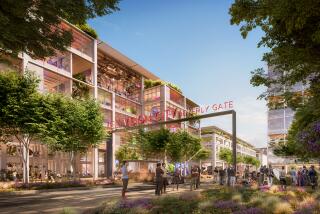Accord Gives New Life to Marketplace of Pasadena
- Share via
PASADENA — After years of delays and financial problems, developer John Patrick Wilson and his partners have signed a preliminary agreement with a Connecticut company to build the ambitious Marketplace project, long considered the cornerstone of Old Pasadena’s redevelopment.
The $60-million project, which would convert a block of decaying buildings at the corner of Colorado Boulevard and Fair Oaks Avenue into a 350,000-square-foot mall, had stalled because of problems in securing financing.
But CMC Capital Corp.’s participation solves the project’s current financial problems and clears the way for the partnership to eventually find financing for the entire project, participants said Wednesday when the agreement was announced.
CMC President Randall Mathieson said the company has provided “substantial funds” to get the project rolling again, including money for engineering, promotions, architectural work, the formation of a leasing operation and the payment of outstanding debts connected with the project.
“The money is already flowing,” he said. “We’re gearing up now and we want this to succeed.” He would not say how much CMC will invest in the project.
There are no plans to make major changes in the Marketplace project, although it may be slightly smaller, he said.
Under an agreement signed last week, a new joint venture has been formed by CMC, Wilson and his partners, Albert Ehringer, Robert J. Morris and Garry Marshall.
Marshall, who owned the property that was to form Marketplace, has wanted to cut back his investment for some time, said a source close to Marshall. Earlier this year Marshall defaulted on payments on several properties in the one-block cluster of buildings that would make up the Marketplace, threatening a possible breakup of the project through foreclosure sales, the source said.
But the new agreement will allow Marshall to get a significant portion of his investment out of the project and provide the funds to pay off the debts on his properties, Mathieson said.
“None of the properties will be lost,” Mathieson said.
Mathieson said there is still some “fine tuning” that must be done before the agreement is finalized, including resolving some problems connected with the defaulted properties.
“We still have some sensitive discussions,” Mathieson said. “But I am proceeding as if everything is in place.”
Marshall’s attorney, Robert N. Solomon, said Wednesday: “We’re real happy with the agreement. They (CMC) are jumping in in a way that is allowing us all to move forward.”
Solomon said Marshall’s Marketplace property will be turned over to the partnership and he will become “a limited partner, and not a funder of the project.”
City Manger Don McIntyre called the agreement an “important breakthrough” that puts the project back on track.
The city has invested $27 million in Old Pasadena to build two parking garages near the Marketplace and has counted on the project to eventually bring in a bounty of revenue from parking fees, sales taxes and jobs.
But for many residents and officials who have been involved with the redevelopment of Old Pasadena, the Marketplace is also a symbol that economic development and preservation of the city’s rich history can progress hand in hand.
McIntyre said the project still must be reviewed by several city agencies, including the Board of Directors, the Community Development Committee and the Design Review Committee.
But unless there are major changes in Wilson’s original plans, McIntyre said, he expects the project to win approval.
“I don’t anticipate any huge problems,” he said. “It has already been wrestled with before.”
Businessmen in Old Pasadena were also relieved that, after years of watching the block of vacant buildings deteriorate, the Marketplace project finally appears to be moving forward.
“I’m delighted, I’m euphoric,” said longtime Old Pasadena business man Jim Plotkin, who owns Pasadena Vacuum & Sewing Center. “I’ve worked all my life to make Old Pasadena happen and my batteries are low, but this re-energizes them again.”
But after the many months of rumors and false starts, there is also some skepticism about the announcement.
‘Hate to Get Hopes Up’
“I hate to get my hopes up and then have it all fizzle again,” said Keith Murphy, the owner of a clothing store, Bijoux Ltd., and a member of the Pasadena Central Improvement Assn. “Once I start seeing things happen, then I’ll believe it.”
The Marketplace project has proceeded in fits and starts since it was presented to city review boards in 1984.
Wilson and his partners had amassed a block of buildings in Old Pasadena, most built in the 1890s. They originally planned to renovate the structures, saving the interiors and exteriors, and convert them into upscale restaurants and shops.
Wilson hoped that a restored trolley would run through Old Pasadena, connecting the Marketplace with parking garages and other shops in the area.
The project was celebrated in April, 1985, with a lavish party and parade in Old Pasadena.
Wilson’s plan gave an enormous boost to Old Pasadena businessmen, who had been slowly renovating their properties and hoped that a major project would draw thousands of more people to the area.
Project Developed Problems
“It gave us our big push,” said longtime business owner Jack Siegal, owner of Jay’s Antiques on Colorado Boulevard. “As soon as I saw Wilson’s plan for the Marketplace, I knew it would go.”
But the project soon began running into problems.
During city hearings on Wilson’s proposal in July, 1985, historic preservation groups, such as Pasadena Heritage, objected to Wilson’s modified plans to gut the old buildings and turn the block into a 350,000-square-foot mall, saving only the facades of the buildings.
Wilson’s plans received conceptual approval from the Community Development Committee that month, but his creditors began complaining that they were owed money.
Creditors said Wilson fired or laid off most of his office staff. He was sued by one creditor, Doug Yates, who claimed that Wilson did not pay him $16,000 of a $35,000 contract to a build model of the Marketplace.
Jim Anodide, general manager of Pasadena Marketplace Ltd., said Birtcher, a national development company, offered to join the partnership in March.
$106-Million Loan
With Birtcher on board, a $106-million loan was secured through the First Interstate Mortgage Co. to fund the Marketplace and plans to develop other properties the group owned in Old Pasadena, he said.
But the loan had one requirement: Birtcher had to provide a $30-million guarantee in case the project failed, he said.
Birtcher balked at the requirement and eventually pulled out of the deal, Anodide said.
Wilson and his partners began negotiating with a number of other companies for a new source of financial support.
But beginning in February, Marshall stopped making payments on seven properties in Old Pasadena and eventually accumulated more than $140,000 in debts by June, according to county land records.
One source close to the project said Marshall purposely defaulted on his payments to force Wilson to find someone else willing to pay for the project.
The idea, the source said, was to put Wilson in a position in which he either had to find a new owner for the properties or risk losing in a foreclosure sale part of the solid block of buildings needed to build the Marketplace.
Began Discussions in May
“It’s a stupid way to get a deal,” Anodide said in May. “It really doesn’t put any pressure on us. We can’t do any more than what we’re doing now to get a deal.”
Mathieson said CMC began discussions with Wilson and his partners in May.
“When I saw what was happening around the neighborhood and the commitment from the city, I knew this project would succeed one way or another,” he said.
CMC, an 11-year-old company based in Wallingford, Conn., primarily manages and develops apartment and office buildings.
He said the company now has more than $500 million in land holdings, mainly on the East Coast and in the Southwest.
“This is the biggest project we’ve had,” he said. “But we thought all the elements were there to make this happen.”
More to Read
Inside the business of entertainment
The Wide Shot brings you news, analysis and insights on everything from streaming wars to production — and what it all means for the future.
You may occasionally receive promotional content from the Los Angeles Times.










